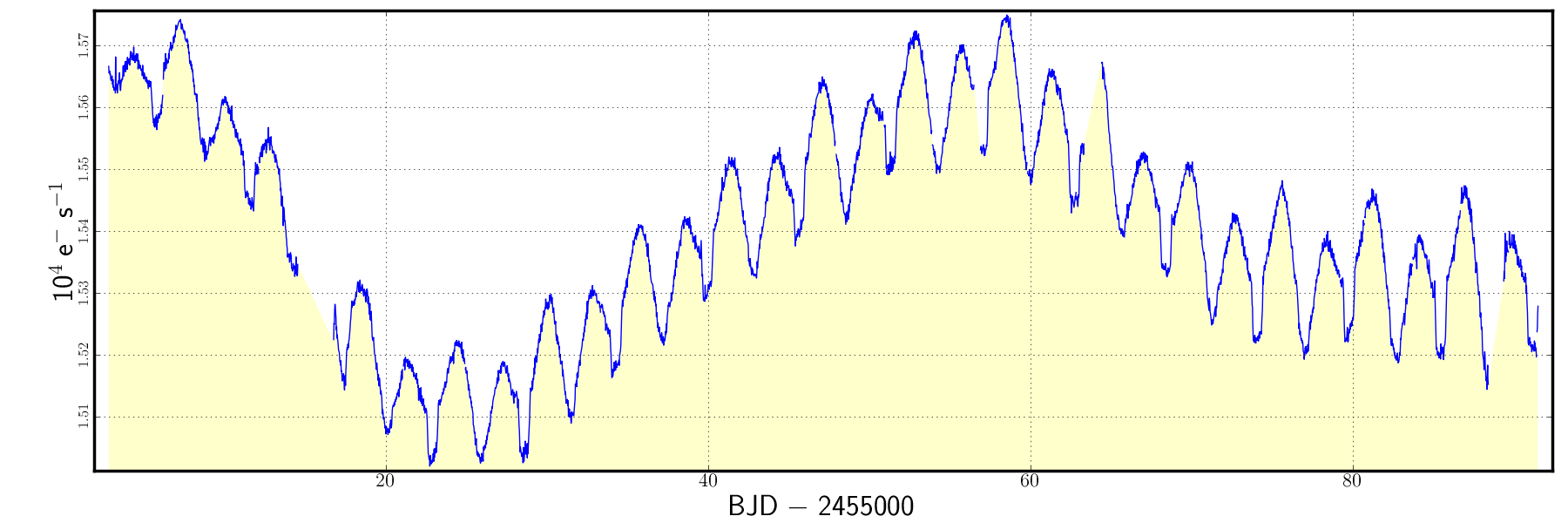|
NAME
keppixseries -- individual time series photometry for all pixels within a target mask
USAGE
keppixseries infile outfile plotfile plottype filter function cutoff clobber verbose logfile status
PARAMETERS
infile = string
The name of a
MAST standard format FITS file containing Kepler Target Pixel data within the first data extension.
outfile = string
The name of the output FITS file. This file has two data extensions. The first called 'PIXELSERIES' contains a table with columns of barycenter-corrected time, barycenter time correction, cadence number, cadence quality flag and a series of photometric light curves, one for each pixel within the target mask. Each pixel is labeled 'COLx_ROWy', where x is the pixel column number and y is the pixel row number on the CCD module/output. The second extension contains the mask definition map copied directly from the input target pixel file.
plotfile = string
Name of an optional diagnostic output plot file containing the results of keppixseries. An example is provided in Figure 1. Typically this is a PNG format file. If no diagnostic file is required, plotfile can be 'None'. The plot will be generated regardless of the value of this field, but the plot will not be saved to a file if plotfile='None'.
plottype = String
keppixseries can plot light curves of three types. The choice is made using this argument. The Options are: local | global | full
- local - All individual pixel light curves are scaled separately to provide the most dynamic range for each pixel.
- global - All pixel light curves are scaled between zero and the maximum flux attained by the brightest pixel in the mask. This option provides the relative contribution to the archived light curve by each pixel.
- full - All pixels light curves are scaled between zero and the maximum flux attained by that pixel. This provides the fraction of variability within each individual pixel.
filter = boolean
If filter=yes, the light curve for each pixel will be treated by a high band-pass filter to remove long-term trends from e.g. differential velocity aberration.
function = string
The functional form of the high pass-band filter. The Options:
boxcar | gauss | sinc
cutoff = float
The frequency of the high pass-band cutoff in units of days-1.
clobber = boolean (optional)
Overwrite the output file? if clobber = no and an existing file has
the same name as outfile then the task will stop with an error.
verbose = boolean (optional)
Print informative messages and warnings to the shell and logfile?
logfile = string (optional)
Name of the logfile containing error and warning messages.
status = integer
Exit status of the script. It will be non-zero if the task halted with an
error. This parameter is set by the task and should not be modified by the
user.
DESCRIPTION
keppixseries plots a light curve for each individual pixel in a target mask. Light curves are extracted from a target pixel file obtained from the Kepler data archive at MAST. If required, the data can be fed through a boxcar, gaussian or sinc function high bandpass filter in order to remove low frequency signal from the data. keppixseries is a diagnostic tool for identifying source contaminants in the background or foreground of the target. It can be employed to identify pixels for inclusion or exclusion when re-extracting a Kepler light curve from target pixel files.
EXAMPLE
- keppixseries infile=kplr010544976-2009201121230_slc.fits outfile=keppixseries.fits period=0.350471 bjd0=2455002.825 bindata=yes binmethod=median threshold=3.0 niter=10 nbins=1000 plottype=sap plotlab='e$^-$ s$^{-1}$' clobber=yes
TIME REQUIREMENTS
Completion upon one target pixel file using a 2.66
GHz Intel Core 2 i7 Mac running OS 10.6.7, takes a few seconds
in addition to the manual input required by the tool.
BUGS AND LIMITATIONS
The Kepler PyRAF package is privately-developed software made available to
the community through the contributed software page of the Kepler astrophysics program at
http://keplergo.arc.nasa.gov/ContributedSoftware.shtml. It is not an
official software product of the Kepler mission or NASA. Bugs and errors are not
the responsibility of the Kepler Team or NASA. Please send bug reports and
suggestions to keplergo@mail.arc.nasa.gov.
HISTORY
|
|
|
|
|
|
|
Initial software release (MS)
|
|
|
|
Trapped error where time=NaN is not flagged in the quality column (MS)
|
|
|
|
Trapped error where flux array is all NaN is not flagged in the quality column (MS)
|
|
|
|
Trapped new behavior of STSCI_PYTHON 2.12 in reading multi-dimension FITS columns (MS)
|
|
|
|
Code can now be run from the command line (TB)
|
|
|
|
more reliable plot rendering on linux operating systems (MS)
|
SEE ALSO
kepmask, kepextract, kepdiffim
|


